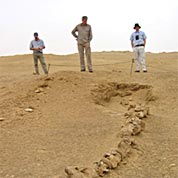Whales in the Desert!
 In 2005, Wadi El-Hitan (Valley of the Whales) in Egypt, located within the Wadi El Rayan Protected Area (WRPA), was designated by UNESCO as a World Heritage Site in recognition of the 40 million-year-old whale skeletons and other species that are found there. In 2005, Wadi El-Hitan (Valley of the Whales) in Egypt, located within the Wadi El Rayan Protected Area (WRPA), was designated by UNESCO as a World Heritage Site in recognition of the 40 million-year-old whale skeletons and other species that are found there.
Wadi El-Hitan was established as a world heritage site (WHS) for its fossil values, which are centered on the fossils of ancient whales from the earliest, and now extinct, suborder of whales, the Archaeoceti (or archaeocetes). These are the ancestors of the two modern suborders of cetaceans (Mysticeti and Odontoceti). The whale fossils of Wadi El-Hitan represent one of the iconic stories of evolution: the emergence of the whales as modern ocean-going mammals from a previous life as land-based animals. According to the World Conservation Union (IUCN) Valley of the Whales is “the most significant site in the world to demonstrate the evolution of whales. This assessment is made in terms of the completeness, quality, concentration and accessibility of the fossils, and the abundant additional evidence enabling a robust construction of the palaeogeography and palaeoecology of the Eocene marine and coastal environment where they are found.”
Wadi El Hitan - Valley of the Whales World Heritage Site in the Western Desert of Egypt is owned by the Egyptian State, and is managed by the Nature Conservation Sector (NCS) of the Egyptian Environmental Affairs Agency (EEAA).
The Italian-funded Egyptian Italian Environmental Cooperation Programme (EIECP) – Phase II, for which IUCN provides the technical support, is undertaking the preparation of a plan for the protection and management of the WHS. The core planning team has prepared a project plan to guide protection and ecotourism development activities. The main components include:
- Establishment of an overall strategic vision and site plan for the area, and updates to the WRPA management plan;
- Identification of economic benefits for neighbouring communities, as focal points for infrastructure development and provision of tourism services;
- Development of information, education and marketing needs and the creation of merchandising products to support local community benefits;
- Preparation of a business plan to establish a means for sustained operations;
- Identification of research, monitoring and reporting functions to support effective management and protection.
A twinning programme has also been established between WRPA and the Italian Gran Sasso National Park. Through this program, 100,000 Euros has been allocated to WRPA, especially for providing engineering and architectural designs for buildings, signs, parking areas, visitor centre infrastructure design and development at Wadi El Hitan as well as environmental education programs.
For more information, please contact:
Dan Paleczny, WRPA International Co-manager (dan.paleczny@iucn.org).
Rami A. Salman, Programme Coordinator, IUCN Centre for Mediterranean Cooperation (rami.salman@iucn.org)
Links: http://www.worldheritagesite.org/sites/wadialhitan.html |